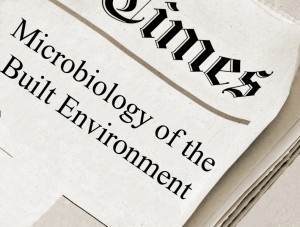Just a quick post on a new paper posted last week at PeerJ. As in the previous post, this is a PeerJ Preprint, meaning it is not peer-reviewed yet. Microbial diversity of extreme habitats in human homes Amy M. Savage​, Justin Hills, Katherine Driscoll, Daniel J Fergus, Amy M Grunden, Robert R Dunn PeerJ Preprints 4:e1874v1 …
Microbes and humans Review: The Anthropocene: a conspicuous stratigraphical signal of anthropogenic changes in production and consumption across the biosphere – Mark Williams – Earth’s Future (OA) Biospheric relationships between production and consumption of biomass have been resilient to changes in the Earth system over billions of years. This relationship has increased in its complexity, …
Forensic microbiology A cloud of distinction – Julian Smith – New Scientist ($1.99) Could the trails of microbes we leave behind be used to solve crimes? Julian Smith picks up the scent. (…) Like our hapless suspect, we all leave traces of our microbes behind. We are haloed by an invisible nebula of bacteria, fungi and viruses. …
Microbes in the house Seasonal Dynamics of the Airborne Bacterial Community and Selected Viruses in a Children’s Daycare Center – Aaron J. Prussin II – PLOS ONE (OA) We have investigated the microbial community of the air in a daycare center, including seasonal dynamics in the bacterial community and the presence of specific viral pathogens. …
New papers about microbes in houses, food, and waste or polluted sites. Microbes in the house Environmental Contamination in Households of Patients with Recurrent Clostridium difficile Infection – Megan K. Shaughnessy – Applied and Environmental Microbiology ($$) Households of R-CDI subjects in the peri-FMT period, and of geographically and age-matched controls, were analyzed for …
Here is another nice paper about microbes degrading human buildings. I guess I am just fascinated by that topic! No matter what we build, microbes will find a way in or on, and will start chewing on things. This paper by a group of Austrian researchers came out a couple of days ago in PLOS …
Set in stone Commentary: Making microbiology of the built environment relevant to design – G. Z. Brown, Jeff Kline, Gwynne Mhuireach, Dale Northcutt and Jason Stenson – Microbiome (OA) Architects are enthusiastic about “bioinformed design” as occupant well-being is a primary measure of architectural success. However, architects are also under mounting pressure to create more sustainable …
Happy Valentine’s Day! Here is a new post expressing my love for everything microbial and built. Based on real science and yes, there is chocolate. The great indoors Indoor microbial communities: Influence on asthma severity in atopic and nonatopic children – Karen C. Dannemiller – The Journal of Allergy and Clinical Immunology ($$) We sought …
Old photographs often are unique artifacts that provide a realistic look into the recent human history. However, many of these older printed photos are deteriorating, due to humidity, temperature, extended light exposure, and biodeterioration. Scientific Reports published a nice paper this week about the microbes found on and in old photographs, called Microbial communities affecting albumen photography heritage: …
Your weekly update of the literature on microbes of the built environment sensu lato. Microbes in the house Rhinitis, Ocular, Throat and Dermal Symptoms, Headache and Tiredness among Students in Schools from Johor Bahru, Malaysia: Associations with Fungal DNA and Mycotoxins in Classroom Dust – Dan Norbäck – PLOS ONE (OA) There are few studies …
